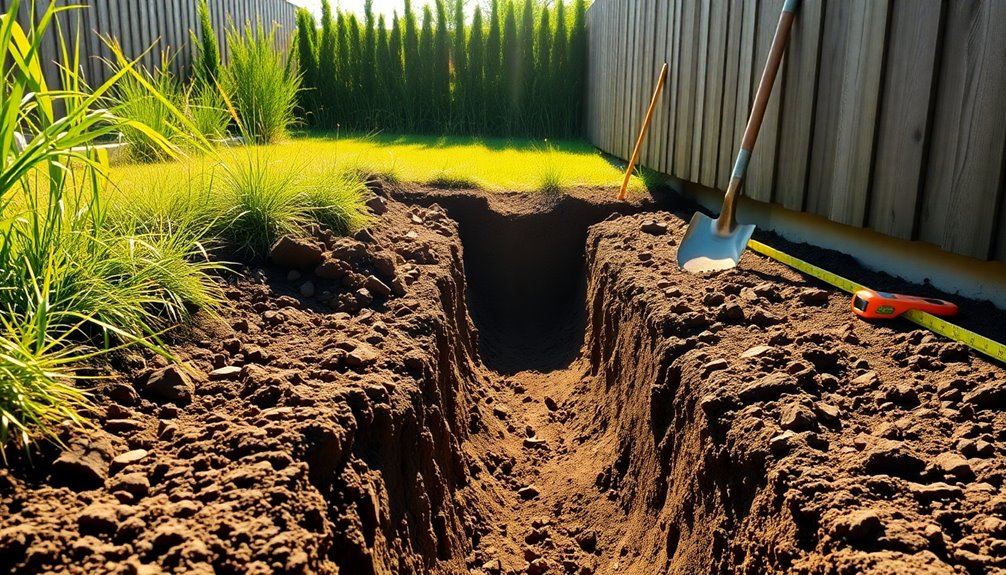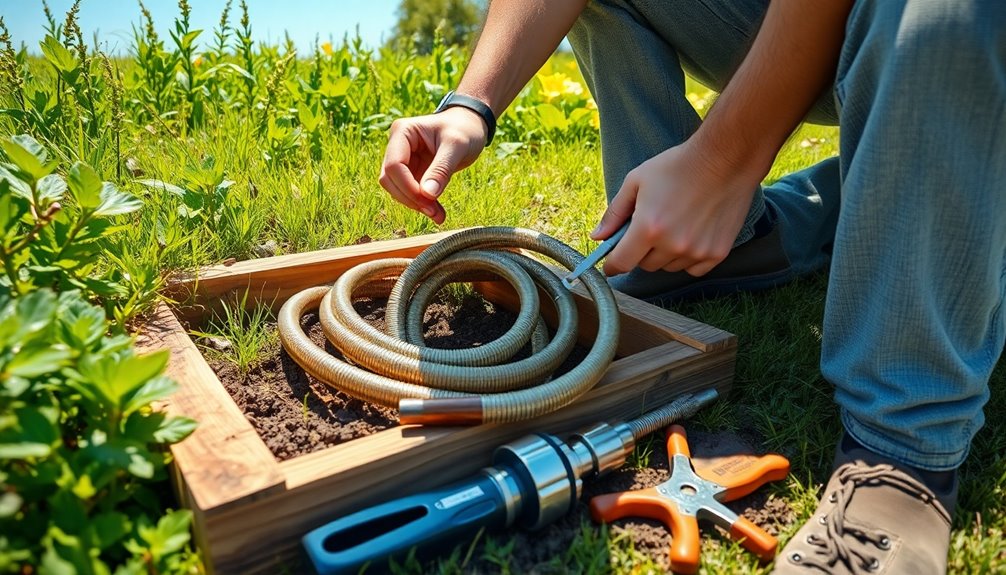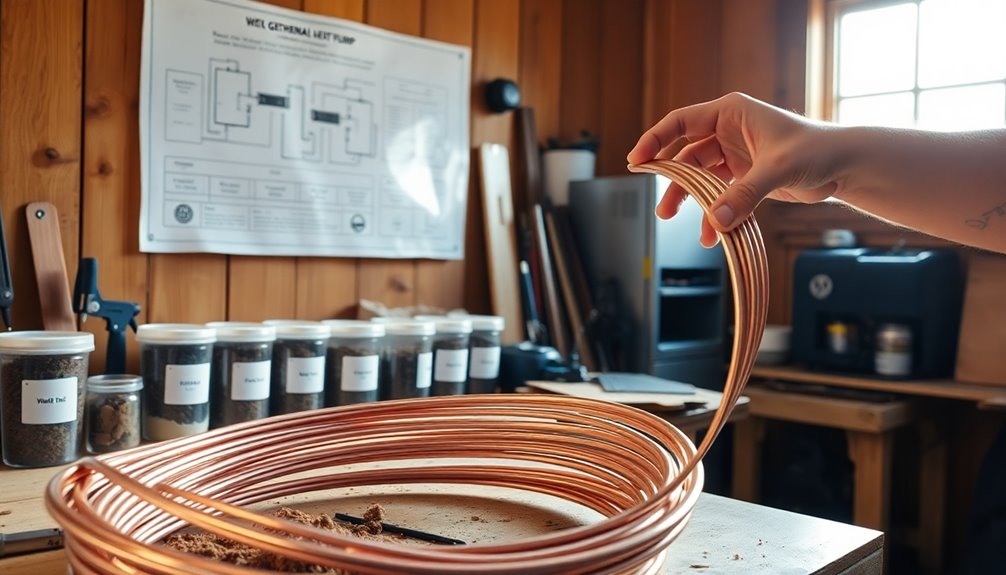You can create an affordable DIY geothermal heat pump system that balances efficiency and cost savings. Start by understanding the different geothermal systems available, and prepare your project by evaluating your site and gathering necessary materials. Next, dig your trench for the loop installation, ensuring proper depth at 4-6 feet. Use HDPE pipes for the loop, and connect everything to your heat pump. Keep an eye on system efficiency by monitoring your setup regularly. With potential tax credits and community rebates, the long-term savings can be significant. Discover more tips to optimize your geothermal system further.
Understanding Geothermal Systems
When it comes to understanding geothermal systems, you'll find they rely on the consistent temperatures found below the Earth's surface. Typically, these temperatures hover around 50-55°F, making geothermal systems more efficient than traditional air-source systems, especially in colder climates.
A popular choice is the closed loop system, where a water/antifreeze mix circulates through buried pipes, absorbing heat from the ground in winter and releasing it during summer. This process not only facilitates effective heat transfer but also leads to significant energy savings. Investment tracking tools can also help homeowners monitor the long-term savings achieved through geothermal systems. Additionally, these systems often feature automated investment management tools that can further enhance financial planning for homeowners.
The U.S. Environmental Protection Agency (EPA) reports that geo-exchange systems can save homeowners between 30-70% on heating costs and 20-50% on cooling costs compared to conventional systems. Ground source heat pumps can achieve a coefficient of performance (COP) of 3.5 to 5, meaning they produce three to five times more energy than they consume. Monitoring savings and investments is crucial for evaluating the long-term financial benefits of such systems.
Understanding the types of geothermal systems—like horizontal loops, vertical loops, pond/lake loops, and well loops—is essential. Your choice should depend on soil conditions and available land, ensuring you select the most suitable option for your project.
Preparing for Your Project
Before diving into your DIY geothermal heat pump project, it's important to lay a solid foundation through thorough preparation. A well-prepared project will save you time and stress during the heat pump installation process. Here are four key steps to help you get started:
- Research Geothermal Systems: Understand the technology and local regulations to guarantee compliance. Knowing how a geothermal system functions is critical for success, and it is essential to explore financial reporting that could help in budgeting for your project. Additionally, familiarize yourself with budgeting tools that can assist in tracking your expenses.
- Assess Your Site: Evaluate soil conditions and available space for the ground loop. Stability in underground temperatures is essential for your system's efficiency.
- Create a Project Plan: Develop a detailed plan that covers your budget, necessary materials, tools, and timelines for each phase of the installation. This will keep everything organized.
- Gather Safety Gear: Confirm you have the right safety gear for excavation. Digging can pose risks, so be prepared. Additionally, consider using expense tracking tools to manage your project costs effectively.
If the task seems too challenging, consider hiring an HVAC contractor for large-scale excavation tasks.
Digging Your Hole

When you're digging your hole for a geothermal system, prioritize safety to prevent any collapses that could lead to serious accidents. Aim for an ideal depth of 4 to 6 feet based on your local frost line, as this will help maximize your system's efficiency. Additionally, consider implementing automated expense tracking to manage the costs associated with the installation effectively. This approach can enhance financial organization, making it easier to keep track of all expenses related to the project. Furthermore, establishing a routine for monitoring due dates can help you stay on top of project costs and deadlines.
Safety Precautions Required
Digging a hole for your geothermal heat pump can be hazardous, so taking safety precautions is crucial. The risks, like potential collapses, can turn a DIY project into a dangerous situation.
Here are four key safety measures to keep in mind while digging holes for geothermal systems:
- Use Proper Shoring Techniques: Always implement shoring techniques to prevent trench collapses. This keeps the sides of the hole stable and safe for you and any workers involved.
- Wear Personal Protective Equipment (PPE): Equip yourself with appropriate PPE, including helmets, gloves, and steel-toed boots. This gear protects against potential hazards during digging.
- Assess Emergency Situations: Have a plan in place for emergency situations. Confirm you have access to first aid and communication devices to respond quickly in case of an accident.
- Stay Aware of Surroundings: Keep an eye on your surroundings while digging. Be mindful of overhead hazards and underground utilities that can pose risks.
Optimal Depth Considerations
Finding the ideal depth for your geothermal heat pump system is vital for maximizing efficiency. The best depth typically varies by geographic zone, but a common recommendation is to dig trenches at least 4 feet deep. This depth guarantees effective heat exchange for your ground-source heat system.
In some regions, deeper excavation may yield better results since ground temperatures stabilize at greater depths, enhancing heat absorption.
When planning your excavation, it's important to take into account local frost lines, usually ranging from 4 to 6 feet. Digging below the frost line prevents freezing in your geothermal loop system, guaranteeing uninterrupted operation.
Remember, water serves as an effective heat exchanger in geothermal systems, so adequate depth is key for improved energy efficiency in heat transfer.
Don't forget safety precautions during your excavation. Small collapses can pose significant risks, so use proper shoring and stabilization techniques to protect yourself and your investment.
Installing the Loop
Now that you've dug your trenches, it's time to focus on the loop design and installation.
You'll want to take into account factors like pipe size and layout to maximize efficiency. Supporting sustainable businesses through your installation choices can also amplify the positive environmental impact of your project. Using proper techniques guarantees your geothermal heat pump operates effectively and meets your heating and cooling needs. Additionally, considering sustainable delivery practices in your overall project can further enhance the eco-friendliness of your installation process. By choosing ethical brands that prioritize environmentally friendly materials, you can ensure that your installation contributes to a more sustainable future.
Loop Design Considerations
When installing the loop for your geothermal heat pump, thoughtful design is essential for efficiency and performance. A well-planned loop design enhances heat absorption and guarantees optimal heat exchange. Here are some key considerations to keep in mind:
- Depth: Install horizontal loops at a depth of 4-6 feet to reach stable ground temperatures, which boosts efficiency.
- Pipe Specifications: Use 3/4 inch HDPE pipe, as it's a common choice. For example, a 600-foot coil can effectively support a 5-ton heat pump.
- Slinky Design: Consider a slinky loop design to minimize trench length while maximizing surface area for heat exchange, making it a cost-effective solution.
- Spacing Loops: Maintain a spacing of 6-10 feet between loops in the trench. This spacing enhances heat absorption and prevents interference between the loops.
Additionally, utilizing a water/antifreeze mixture within the HDPE pipes improves thermal conductivity and prevents freezing, guaranteeing efficient heat transfer throughout your geothermal system.
Pipe Installation Techniques
Installing the loop for your geothermal heat pump requires careful attention to detail to guarantee peak performance. You'll typically use 3/4-inch HDPE pipe, buried in trenches instead of drilled vertical shafts, which keeps costs down. For a 5-ton heat pump, aim for six 600-foot coils to effectively harness heat from the ground.
The trench should be 4 to 6 feet deep, depending on your local frost line, to optimize heat exchange. Proper planning is vital; the configuration and length of your piping greatly influence your system's efficiency and performance.
Consider utilizing a slimy loop design to maximize the amount of piping in the ground while minimizing trench length, enhancing heat energy absorption.
You can find affordable piping at local home improvement stores, typically around 10 cents per foot, making it budget-friendly for DIY enthusiasts. Although you might manage this project yourself, you can always consult an HVAC company if you have questions or need assistance.
Setting Up the Pump

Setting up your DIY geothermal heat pump requires careful attention to detail, especially in repurposing components for ideal performance.
Start by verifying you have a compatible fuel pump, like one from a 90s Honda Civic. This will optimize both cost and efficiency for your geothermal system.
Follow these steps for proper installation:
- Install the Heat Exchanger: Use an aftermarket radiator from the same vehicle model to facilitate effective heat transfer.
- Electrical Connections: Make certain your geothermal system runs on a 12-volt power supply. Secure all wiring to avoid electrical issues that could disrupt the pump's operation.
- Connect the Pump: After setting up the loop, carefully connect the pump to the heat exchanger. Confirm all fittings are tight to prevent leaks.
- Monitor System Sounds: Familiarize yourself with the audible water flow sounds. These indicate proper circulation of the water-antifreeze mixture, essential for maintaining the temperature difference throughout your setup. Additionally, understanding the importance of financial literacy can help you budget effectively for your DIY project. It's also beneficial to utilize budgeting apps that can assist in tracking expenses for materials and tools needed for the installation. By using these tools, you can gain insights into your spending habits, promoting financial awareness as you manage your project costs.
Ensuring System Efficiency
To achieve ideal efficiency in your DIY geothermal heat pump system, you must consider several key factors.
First, verify the piping is adequately sized and buried at a suitable depth of 4 to 6 feet for your geographic zone. This depth helps leverage stable ground temperatures, greatly enhancing your system's heating capabilities.
Next, utilize slow pump operation to improve heat exchange efficiency. Slower circulation allows the water/antifreeze mixture to absorb more heat, maximizing the overall performance of your geothermal pumps.
Incorporating a desuperheater can also boost your domestic hot water efficiency by utilizing excess heat, further increasing your system's energy output.
Don't overlook regular maintenance, either. Checking for leaks and verifying proper insulation of pipes can prevent energy loss, maintaining your system's efficiency over time.
Finally, monitor the Coefficient of Performance (COP) of your geothermal system. A COP above 3.5 indicates that your system is generating 3.5 times more energy than it consumes, showcasing exceptional performance.
Financial Incentives and Savings

Investing in a geothermal heat pump system can lead to significant financial rewards. By taking advantage of financial incentives and tax benefits, you can substantially reduce your initial investment and enjoy long-term savings.
Here's how you can maximize your return on investment:
- Federal Tax Credit: You can receive a 30% tax credit on your geothermal installation, bringing the total cost down from around $11,000 to just $7,500.
- Low Monthly Bills: Monthly heating and cooling costs can drop below $100, compared to over $400 for traditional propane heating systems.
- Energy Efficiency: Geothermal systems can save you 30-70% on heating and 20-50% on cooling costs, ensuring significant savings year after year.
- Local Incentives: Check for community programs that offer rebates, providing additional financial support to make your DIY geothermal project even more accessible.
Conclusion
With your affordable DIY geothermal heat pump in place, you've not only embraced eco-friendly living but also transformed your home into a cozy haven. You've turned the earth beneath your feet into a reliable ally, providing warmth in winter and coolness in summer. As you reap the rewards of energy savings, you'll find that this labor of love is more than just a project; it's a step toward a sustainable future. Enjoy the comfort and savings you've created!



